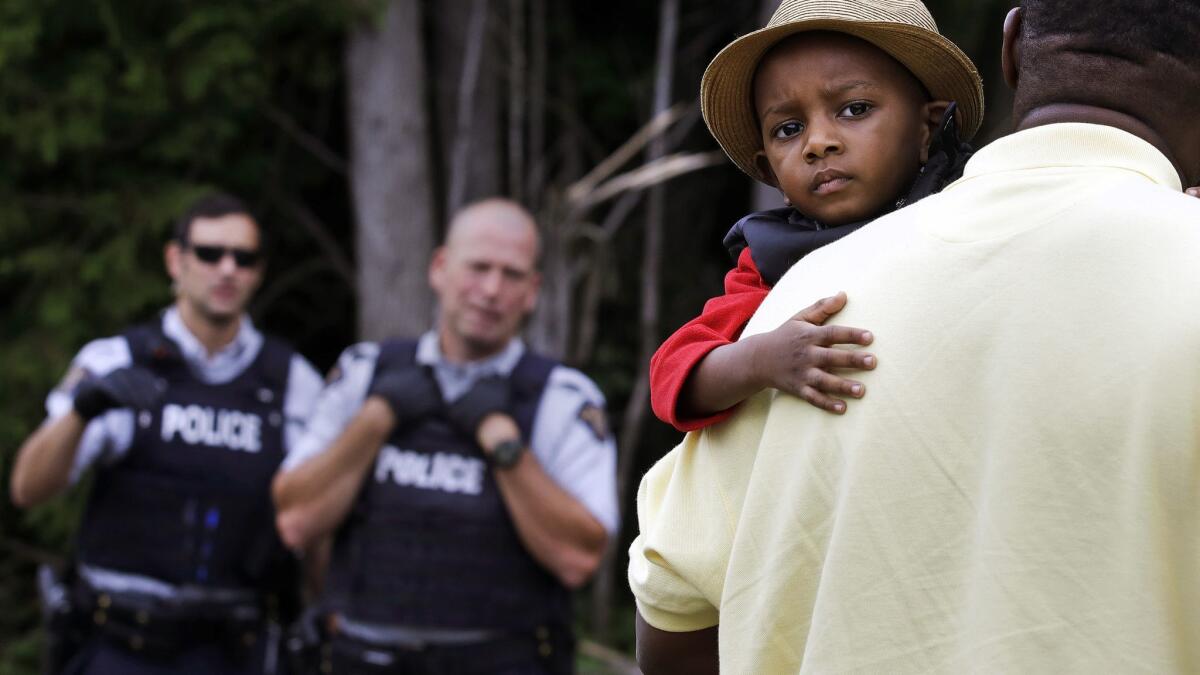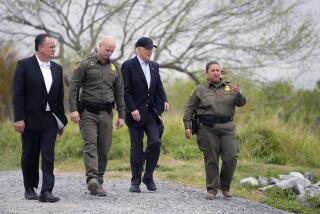As U.S. hardens its borders, Canada debates whether to do the same or stand up to Trump

Gbolahan Banjo says his bisexuality led to ostracism and beatings in his native Nigeria, where same-sex relationships are forbidden. So in early June, he made his way to a deserted road in upstate New York and walked across the border and into Canada.
“I was tired of running for my life,” the 48-year-old said 11 days later as he waited to speak to an immigration lawyer in Montreal about his request for asylum protection.
After arriving in the U.S. on a tourist visa in December and recovering in Newark, N.J., from the beatings he’d endured, Banjo traveled a well-worn route for asylum seekers, many of whom arrive in the U.S. but see no hope of refuge since President Trump began hardening the country’s borders.
Now those get-tough policies are affecting Canada’s long-standing and smooth-functioning immigration system, which has taken on thousands of new asylum requests.
The policies also have ignited a heated debate between those seeking tighter border controls and others who want the Canadian government to stand up to Trump’s immigration moves.

Andrew Scheer, leader of the opposition Conservative Party, sent a letter to Prime Minister Justin Trudeau this month demanding that the government stop the “queue jumping” by asylum seekers such as Banjo, who enter Canada at unofficial crossings.
Jean-Francois Lisee, leader of the separatist Parti Quebecois, in April floated the idea that Canada erect a fence on the its side of Roxham Road in upstate New York where Banjo and thousands of other asylum seekers have entered Canada. Lisee later backpedaled a bit, saying he envisioned more of a plant hedge than the massive wall Trump wants to build along the Mexican border.
But pressure also has mounted on the government to rethink, and possibly abandon, a bilateral agreement that for 14 years has enshrined the principle that the U.S. and Canada share similar standards when deciding asylum requests. The Safe Third Country Agreement requires that people seek asylum in the first country they enter — either the U.S. or Canada — under the premise they’ll be treated the same at either border.
But Trump’s “zero tolerance” approach at the border has changed that.

“Trump policies that separated children from their families at the Mexican border has added to a real sense of unease and opposition to the agreement we have with the U.S.,” said Lloyd Axworthy, chair of the World Refugee Council at Canada’s Center for International Governance Innovation and a former foreign minister.
Axworthy has joined a growing chorus demanding that the government suspend the agreement. They argue that U.S. policies, including no longer providing asylum in cases of domestic and gang violence, are out of sync with Canadian policies in practical, and even ethical, terms.
The agreement states that asylum seekers who first land in one country can be turned back at an official border crossing of the other. A loophole allows immigrants such as Banjo to enter Canada at unofficial crossings and then claim refugee status.
Two days before Trump signed an executive order stopping future family separations, Jenny Kwan of the New Democratic Party made an emotional plea in Parliament for the suspension of the Safe Third Country Agreement because of the shifts in U.S. immigration policy.
“These practices are blatant violations of international law,” Kwan said. “If Canada doesn’t step up, then we are complicit.”
Trudeau called the Trump family separations “wrong” while his immigration minister, Ahmed Hussen, said the government was monitoring the situation in the U.S., adding, “We will continue to be a country that is open to refugees and protected persons.”
The immigration debate comes at a time of worsening U.S.-Canada relations and the relationship between the two leaders has been tense since a summit of Group of 7 leaders in Quebec in early June when Trump called Trudeau weak and refused to sign a joint agreement on economic and foreign policy goals.
“Canceling or reopening the Safe Third Country Agreement would become another irritant in already tense negotiations,” said Mireille Paquet, a professor of political science at Concordia University in Montreal, who studies the politics of immigration.
Paquet and other political observers believe the Trudeau government will not make any moves soon regarding the agreement, especially while facing difficult negotiations with the U.S. on the North American Free Trade Agreement and tariffs.
Conservative members of Parliament, meanwhile, have stepped up demands for tighter border controls.
They would like the government to close the loophole in the Safe Third Country Agreement by declaring the entire length of the border an official entry point, allowing authorities to turn back asylum seekers who simply walk into Canada. Critics, though, say it would be impossible to police the entire length of the border and could encourage human trafficking.
According to official immigration targets set by the government, Canada will approve 310,000 new permanent residents in 2018, with 177,500 chosen through a point system for job skills and education levels and the rest divided between family reunifications and refugees.
Throwing a wrench into the system are the unexpected arrivals, such as Banjo.
From January through May of this year, Royal Canadian Mounted Police intercepted 9,481 people entering the country at unofficial crossings along the U.S. border. Last year, more than 20,000 asylum seekers came into Canada outside the official system, government statistics showed.

Although some of the pressure on services has eased since the first wave of asylum seekers last summer forced the government to provide temporary housing in Montreal’s Olympic Stadium, agencies working with immigrants here continue to juggle increased demands.
CACI, a nonprofit center for immigrants in Montreal, offers French classes and job search support to immigrants granted permanent residence though the official system, but has seen demand for its services to asylum seekers increase dramatically in the last year, according to its executive director, Anait Aleksanian.
As many as 20 newly arrived asylum seekers show up at its offices each day, she said. Employees help them with applications for work permits and enrolling children in school. Some receive rations from the center’s food bank.
Banjo, the Nigerian asylum seeker, is living in a YMCA shelter in Montreal. His asylum request won’t be heard until March. So he waits.
“Hope is the last thing people keep,” he said.
Haller is a special correspondent.
More to Read
Start your day right
Sign up for Essential California for news, features and recommendations from the L.A. Times and beyond in your inbox six days a week.
You may occasionally receive promotional content from the Los Angeles Times.






